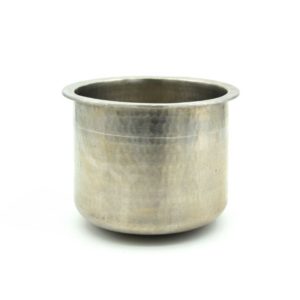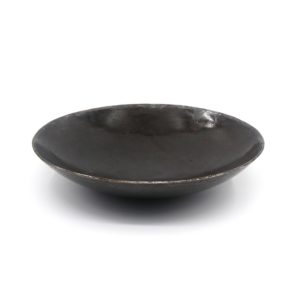The waft of Rasam made in a tin vessel is always special. The most relished “Kalyana Rasam”(Wedding rasam), made for weddings have a distinct taste and aroma, owes its flavor to the use of tin vessels. Wedding meals are prepared in huge vessels and tin is an expensive metal and therefore in order to bring in the flavor, chefs add a small tin vessel inside the huge rasam pots, which is later removed after the dish is ready to serve.
There is a common misnomer about tin vessels because of its Tamil name. Tin is commonly called as eeya pathiram. Though the it was originally called Velleeyam (Vell refers to white), as time passed, people started calling it eeyam. Another metal, namely Lead is called as Kaareeyam (Kaar meaning black or dark) and as both metals have eeyam in common, people started confusing one with the other. Tin is Velleeyam and is safe to be used for cooking. It is a soft malleable metal and therefore the cooking procedure for common recipes will differ when this cookware is being used.
 Tin vessels are commonly used in South Indian households to make rasams and More Kulambu(buttermilk gravy). For both the above mentioned recipes, all the ingredients are added to the tin vessel before it is placed on the flame. These recipes in general do not require a lot of prolonged heating to cook. In Ayurveda, Tin holds a special place. It is an important metal for maintaining good tissue health.
Tin vessels are commonly used in South Indian households to make rasams and More Kulambu(buttermilk gravy). For both the above mentioned recipes, all the ingredients are added to the tin vessel before it is placed on the flame. These recipes in general do not require a lot of prolonged heating to cook. In Ayurveda, Tin holds a special place. It is an important metal for maintaining good tissue health.
With continued usage, tin vessels that are shiny and whitish when new, start to get dimmer and have a slight yellowish tinge due to the usage of masala in our recipes. This is normal. Tin vessels cannot be held with tongs as this might damage the soft metal. It is best to use a thick cloth to move the tin vessel from the stove to your counter top. It is best to leave the rasam in the same vessel till it is consumed. Tin vessels were used for setting curds and storing idly batter too.
Tin coated brass, bronze and copper vessels have been in use in India for many years. There is evidence of tin coating being given to cookware made of copper since the times of Kings and queens across the country. It is said that the Kings cookware were polished with tin twice every month while the other royalty had it polished once a month. Such is the history of Tin being used in cookware lining.
Though traditional cookware such as tin vessels and tin coated vessels are making a comeback, the number of artisans who are well versed at this art are dwindling. Due to poor patronage and work environments, artisans are giving up their accumulated knowledge for other opportunities. There are still some artisans who understand the science behind working with Tin in specific pockets of our country. One such pocket is in the temple city of Kumbakonam in Tamil Nadu. At Essential Traditions, we source our pure tin vessels from one such artisanal group. The flavor that such traditional impart to a dish is unique and can be appreciated only when one cooks with them and experiences the subtle variations in cook time, flavor, aroma etc. We hope that in our endeavor to bring back some of this lost cookware we are able to nourish and encourage a new set of artisans to continue thriving in this community.










